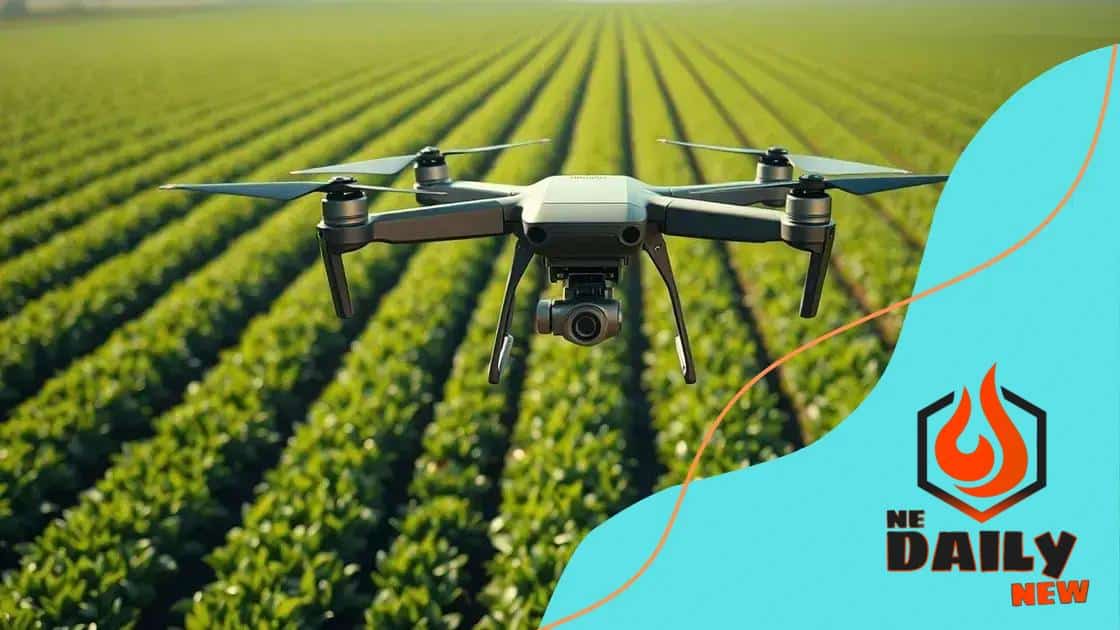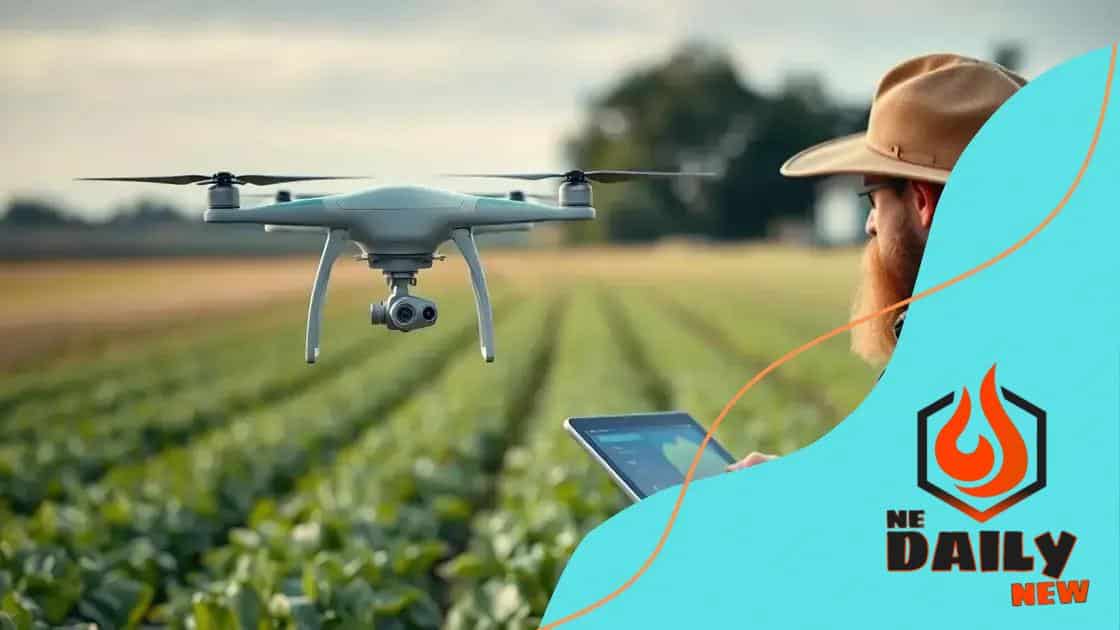The role of drone technology in modern agriculture

The role of drone technology in modern agriculture enhances crop monitoring, improves resource management, and promotes sustainable practices, despite challenges like costs and regulations.
The role of drone technology in modern agriculture is becoming increasingly vital. Have you ever wondered how drones can enhance farming methods and boost productivity? Let’s dive into this technology that’s reshaping the industry.
Understanding drone technology in agriculture
Understanding drone technology in agriculture is crucial for modern farming. Drones are changing how farmers collect data and manage their fields effectively. With the power of drone technology, agricultural practices have been revolutionized, leading to better yields and efficient resource management.
What are Agricultural Drones?
Agricultural drones are unmanned aerial vehicles (UAVs) equipped with technology to collect data about crops. They can be used for various tasks such as crop surveying, mapping fields, and monitoring crop health. These drones provide real-time insights that help farmers make informed decisions.
Key Benefits of Using Drones
- Efficiency: Drones can cover large areas quickly and accurately.
- Data Collection: High-resolution images offer significant insights into soil conditions and crop health.
- Cost-Effectiveness: Reduces the need for manual labor and lowers operational costs.
- Precision Agriculture: Helps in identifying problems before they become serious, allowing for targeted interventions.
Farmers can also utilize drones to monitor irrigation systems efficiently. By capturing images of the fields from above, drones enable farmers to pinpoint areas that require additional water. This precise water management ensures that crops receive the right amount of water without wastage.
As technology progresses, features in drone technology are also improving. Many drones now include advanced sensors and AI analytics that enhance their capabilities. This allows for even more insightful data collection, driving precision farming forward.
With the growing interest in sustainable practices, farmers are increasingly relying on drone technology to assist them in implementing eco-friendly solutions. By observing crop stress levels, drones help reduce chemical use and promote healthier farming methods.
Benefits of drones for crop monitoring
The benefits of drones for crop monitoring are immense and provide farmers with innovative ways to manage their fields. Utilizing drone technology allows for more accurate and efficient monitoring of crop health, leading to higher yields and better resource management.
Enhanced Data Collection
Drones can collect high-resolution images and data on various crop conditions. This data provides farmers with insights into soil health and crop growth. By identifying areas that need attention, they can apply resources where they are needed most.
Real-Time Monitoring
Farmers can use drones to monitor their fields in real-time. This capability means that any issues can be spotted quickly. When a problem arises, such as pests or disease, they can address it immediately, preventing further damage.
- Accuracy: Drones provide precise imaging that helps isolate problem areas.
- Accessibility: Farmers can easily access remote or difficult-to-reach areas.
- Cost-Effectiveness: Using drones reduces the need for extensive manual checking, saving time and labor costs.
- Improved Productivity: With detailed insights, farmers can increase their overall productivity.
Moreover, the use of drones enhances precision agriculture. By collecting data on crop health and soil conditions, farmers can apply nutrients and chemicals more efficiently. This tailored approach not only reduces waste but also promotes sustainability.
The integration of drones into farming practices promotes smarter decision-making. As farmers become more informed, they can adopt more effective farming strategies, which contribute to better environmental practices. Using less water and fewer chemicals leads to healthier crops and more sustainable methods.
In addition to crop health monitoring, drones play a role in assessing field conditions after extreme weather events. After storms or droughts, farmers can evaluate the impact quickly, allowing them to plan their next steps effectively.
How drones enhance precision agriculture

Drones play a significant role in enhancing precision agriculture by providing farmers with detailed insights into their fields. By leveraging drone technology, farmers can improve crop management and optimize resource usage.
Advanced Imaging Techniques
One of the key ways drones enhance precision agriculture is through advanced imaging techniques. Drones are equipped with high-resolution cameras and sensors that capture images of the fields from an aerial perspective. These images reveal variations in crop health, allowing farmers to identify issues such as nutrient deficiency or pest infestations.
Efficient Resource Management
Using drones allows for more efficient resource management. Farmers can monitor soil conditions and crop growth patterns, enabling them to apply fertilizers and water precisely where needed. This targeted approach helps reduce waste and lowers costs.
- Soil Health Monitoring: Drones can assess soil health by capturing data that indicates moisture levels and nutrient content.
- Variable Rate Application: Farmers can customize how much fertilizer or pesticide is applied based on the specific needs of different field areas.
- Yield Prediction: Drones can help predict yield by assessing crop conditions throughout the growing season.
- Time-Saving: Drones cover large areas quickly, saving farmers time compared to manual inspections.
Moreover, drone technology fosters a more sustainable approach to agriculture. By applying inputs only when and where necessary, farmers can minimize environmental impact. This method not only conserves resources but also supports healthier ecosystems.
Farmers can also integrate data collected from drones with farm management software. This integration creates a comprehensive view of the field conditions, helping farmers make informed decisions. As the agricultural landscape evolves, these technologies are becoming essential tools for efficient farming practices.
The future of agriculture looks promising with the advancing drone technology. As more farmers adopt these systems, we can expect greater efficiency and productivity, which is crucial for feeding a growing global population.
Case studies of successful drone use
Case studies of successful drone use in agriculture illustrate how innovative technology can optimize farming practices. Various farms have adopted drone technology to improve efficiency, monitor crops, and increase yields.
Example 1: Precision Crop Monitoring
One notable case study involves a farm in California that implemented drones for precision crop monitoring. By using drones equipped with multispectral cameras, the farm could gather detailed images of its crops. This data revealed areas of stress due to pests and nutrient deficiencies.
Results
As a result, the farm was able to target treatments more effectively. By applying fertilizers and pesticides only where necessary, they reduced chemical use by 30%. This led to healthier crops and a significant increase in yield by 15% within one growing season.
Example 2: Irrigation Management
Another compelling case comes from a farm in Nebraska that focused on irrigation management. Drones were utilized to create detailed maps of the field, showing variations in soil moisture levels. This allowed farmers to identify which areas required more water.
- Efficiency Improvements: The farm managed to cut water usage by 40% through more targeted irrigation strategies.
- Yield Increase: Improved irrigation led to a 20% uptick in crop yields.
- Cost Savings: Reduced water and energy costs significantly improved the farm’s profit margins.
Both examples highlight how drones enable farmers to adopt more sustainable practices while improving productivity. By providing insights that traditional methods cannot, drones are transforming the agricultural landscape.
The integration of drones into these farming operations demonstrates the potential of technology to address challenges in agriculture. As more farmers share their success stories, the adoption of drone technology is expected to grow, creating a ripple effect across the industry.
Challenges and future of agricultural drones
Challenges and the future of agricultural drones present an exciting yet complex landscape for farmers. As drone technology continues to evolve, understanding the hurdles is crucial for adoption and success.
Current Challenges
One major challenge farmers face is regulatory restrictions. Many regions have strict laws regarding drone usage, which can hinder operational capabilities. Another significant issue is the cost. High initial investment for drone technology can be a barrier for small to medium-sized farms.
Technical Difficulties
Technical difficulties also pose challenges. Drones require proper training and knowledge to operate effectively. The learning curve can be steep, particularly for older farmers or those not familiar with technology.
- Data Management: Handling and interpreting the vast amounts of data collected can overwhelm users.
- Weather Conditions: Drones can be affected by adverse weather, impacting their performance and reliability.
- Battery Life: Limited battery life can restrict the area a drone can cover in one flight.
Looking ahead, the future of agricultural drones is promising. With ongoing advancements in technology, drones are becoming more accessible. New models are being developed that are easier to operate and more cost-effective.
Integration with artificial intelligence (AI) and machine learning is one significant trend. These technologies will enhance data analysis, providing farmers with actionable insights. For example, predictive analytics can forecast crop yield and monitor field conditions over time.
Furthermore, collaboration with agricultural software systems is expected to improve the utility of drones. Farmers will be able to combine drone data with their farm management solutions, creating a comprehensive view of their agricultural activities.
As the challenges are addressed, more farmers are likely to embrace drones as essential tools for modern agriculture. The evolving landscape promises not only improved efficiency but also sustainable farming practices that benefit the environment.
In summary, the role of drone technology in modern agriculture is transforming the industry. Drones provide farmers with essential tools for monitoring crops, managing resources, and improving yield. Although challenges such as regulations, costs, and technical difficulties exist, the future looks bright as technology continues to advance. With the integration of AI and improved data management, drones will become increasingly indispensable for farmers, leading to more sustainable and productive agricultural practices.
\n
\n
FAQ – Frequently Asked Questions about Drone Technology in Agriculture
How do drones improve crop monitoring?
Drones provide high-resolution images and data, helping farmers identify issues like pests and nutrient deficiencies quickly.
What are some challenges in adopting drone technology?
Challenges include regulatory restrictions, high costs, and the need for proper training to operate drones effectively.
How can drones enhance resource management?
Drones allow for precise application of fertilizers and water, reducing waste and improving overall efficiency in farming.
What is the future of drones in agriculture?
The future includes advancements like AI integration, which will provide better data analysis and insights for farmers, promoting sustainability.





